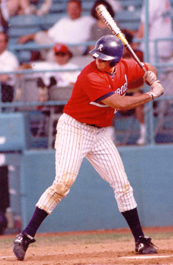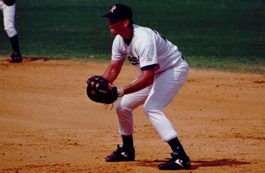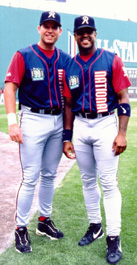Jan. 28, 2009
Casey: Becoming ‘The Mayor’
By Sean Ryan, CBI Co-Founder
 Before
he became “The Mayor,” he was “Mungo,” a happy-go-lucky freshman
from Pittsburgh who nearly didn’t get the chance to play
Division I college baseball. Before
he became “The Mayor,” he was “Mungo,” a happy-go-lucky freshman
from Pittsburgh who nearly didn’t get the chance to play
Division I college baseball.
Some 16 years later, Sean Casey is hanging up his
spikes. A three-time all-star, winner of the 1999 Hutch Award
and landslide favorite for the friendliest player in baseball,
“Case” will take his passion for baseball and love of
conversation to the MLB network.
It seems appropriate. After being drafted in the
second round and leaving the University of Richmond after his
junior year, Sean made good on a promise to return and complete
his degree in speech communications.
I was fortunate to arrive at Richmond in the fall
of 1992, the same year Sean became a Spider. When people find
out I was a teammate of his for three years, the first question
I’m always asked is, “Is he really as nice as he seems?”
Yes, he really is.
Don’t want to take my word for it? In a 2007
Sports Illustrated poll, Sean was named the friendliest
player in baseball by 46 percent of his major league peers. Jim
Thome, ironically the guy who stood in Casey’s way in Cleveland
and paved the way for a trade to Cincinnati, was second, with 7
percent of the vote.
At Richmond, Sean made friends like the United
States Mint makes coins. The first time I met him was at an
athletic department gathering for new athletes on campus. He
bounded into the room with another Pittsburgh guy, Jay Adams,
who would become one of his closest friends. The pair bounced
from person to person, shaking hands like politicians, laughing
like they had met everyone in the room 100 times before.
A couple years later, the student body named him
homecoming king, an honor I’m sure embarrassed him at least a
little.
 On
the field, he made even more friends. He honed his conversation
skills at first base, talking to anyone and everyone who reached
base. By the time runners got to third, they’d often turn to me
and say, “Is he always like that?” or “Does he talk to
everyone?” I’d always laugh and nod. What conversations I
had with runners were short – most of the runners, thoroughly
distracted by Sean at first, weren’t about to let it happen at
third. Besides, how could you follow up Case? On
the field, he made even more friends. He honed his conversation
skills at first base, talking to anyone and everyone who reached
base. By the time runners got to third, they’d often turn to me
and say, “Is he always like that?” or “Does he talk to
everyone?” I’d always laugh and nod. What conversations I
had with runners were short – most of the runners, thoroughly
distracted by Sean at first, weren’t about to let it happen at
third. Besides, how could you follow up Case?
Opposing players became buddies. Fierce rivals
Kevin Gibbs and Matt Quatraro from Old Dominion joined us for
dinner one night in the midst of a three-game conference series.
I’m sure Sean invited one of those guys to join Bobby St. Pierre
(who grew up with Gibbs), Mark Budzinski (Bud) and I one of the
many times they visited him at first.
As a teammate, there isn’t enough space – even on
the Internet – to capture the highlights he provided or stories
he told. His cramps on the team vans were legendary, as were his
occasional sleep-walking stories. Athletic trainer Eric Sugarman,
now the head athletic trainer with the Minnesota Vikings,
tricked Sean at William & Mary by putting eye black under one
eye, leaving the rest of the team in stitches, especially when
Sean chased “Shoogs” into the outfield.
And of course, Sean could hit. Like none other I
saw in my four years. Which always made us wonder how he ended
up at Richmond. He almost didn’t.
Sean was set to go to Penn State-Behrend – not
even Penn State, but Penn State-Behrend as Sean used to
tell me. But a funny thing happened. Assistant coach Mark
McQueen, now the Spiders’ head coach, took a drive up to see
Sean play in the Keystone Games on a field that didn’t have a
fence. Case responded by using his sweet, left-handed stroke to
pepper the ball around the yard. McQueen returned with a glowing
report. Head coach Ron Atkins made him a tiny scholarship offer.
I always thought the fact that he was so
overlooked made him work that much harder. He wasn’t a great
first baseman when he arrived, often replaced in the late
innings by his great friend Bud. Sean took that personally and
came back his sophomore year with a gold glove that saved many
an infielder error.
Three years after he arrived, Sean hobbled up to
the plate in an NCAA elimination game against Alabama at the
Clemson Regional. Case had battled a bad hamstring down the
stretch in helping lead us to an at-large bid. When he stepped
to the plate, many of us wondered if we might be watching his
last at-bat in a Spiders uniform. Alabama had the game in
control, and the Major League Draft beckoned.
Sean, whose first hit as a Spider was a double to
left-center, stepped in and drilled one last ball to the gap. He
rounded first and gingerly trotted into second for one last
double. I remember having tears in my eyes as he came off the
field for a pinch-runner – the emotion of watching him leave the
field for the last time and the finality of the best year in
school history (to date) was tough to contain.
What none of us knew then was that with that
double, Sean passed a guy at Indiana State to become the NCAA
batting champ.
 Sean
went on to put together a fantastic major league career. How
many guys can say they batted .300 for their career or racked up
more than 1,500 hits? Or named to the epic All-Star Game in
Boston (pictured left, with former Spider Brian Jordan), where
he was one of many awestruck players who flocked to the immortal
Ted Williams? Or belted two homers in the World Series in front
of hordes of close, personal friends who supported him
throughout his career? Or picked up the first hit in the new
ballpark in the “City of Champions” as he liked to call the town
where he grew up. Sean
went on to put together a fantastic major league career. How
many guys can say they batted .300 for their career or racked up
more than 1,500 hits? Or named to the epic All-Star Game in
Boston (pictured left, with former Spider Brian Jordan), where
he was one of many awestruck players who flocked to the immortal
Ted Williams? Or belted two homers in the World Series in front
of hordes of close, personal friends who supported him
throughout his career? Or picked up the first hit in the new
ballpark in the “City of Champions” as he liked to call the town
where he grew up.
What amazes me the most about Sean is that he
didn’t change a bit as he made it big. He remembered your name,
even if you met him for only seconds years ago. He left tickets
for teammates, fraternity brothers, friends, friends of friends
and people he’d met along the way. He signed more autographs
than anyone this side of Bob Feller, whom he accidentally
drilled in the chest with a baseball when he was a kid in the
Indians’ organization and momentarily thought he had ended the
life of one of Cleveland’s finest. And he devoted countless
hours to charitable causes all around the country.
When Bud finally reached the Major Leagues after
about 10 years in the minors, Case was the happiest guy in the
world. His good friend was going to join him on the Reds, and
Sean gobbled up just about every player ticket to accommodate
Bud’s friends and family for a Sunday night game against the
Giants at the Great American Ballpark.
That’s just the way Sean is.
And how he became The Mayor.
'The Mayor' leaves affable legacy (Chris
Haft/MLB.com)
Casey officially announces retirement (Mark Sheldon/MLB.com)
Casey joins MLB Network team (Barry M. Bloom/MLB.com)
(photos courtesy of Richmond Media
Relations Office)
|